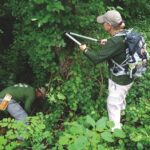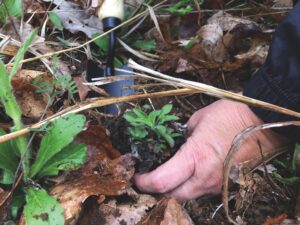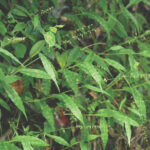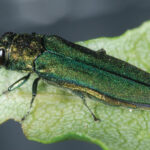Invasive Species: A Growing Threat to the Trail’s Biodiversity

Jun 4, 2025


Heather B. Habelka
Jun 4, 2025

“Second only to climate change, non-native invasive species are the most urgent threat to the Appalachian Trail’s 2,000 miles and almost 400,000 acres of land,” says Marian Orlousky, the ATC’s Director of Science and Stewardship. To combat this threat, the ATC is strategically managing both existing and emerging non-native invasives that have taken hold throughout the Trail’s 14 states.
 Non-native invasive is a general term used to describe species of plants, animals, and pathogens that are not native to a specific area and have the capacity to cause significant negative impact or harm. These species adapt to — and thrive in — new habitats and generally reproduce quickly. In doing so, non-native invasives damage native plants and animals and impact surrounding property and the regional economy.
Non-native invasive is a general term used to describe species of plants, animals, and pathogens that are not native to a specific area and have the capacity to cause significant negative impact or harm. These species adapt to — and thrive in — new habitats and generally reproduce quickly. In doing so, non-native invasives damage native plants and animals and impact surrounding property and the regional economy.
On the Trail, the ATC monitors how non-native invasive species compete with native species for limited natural resources, including sunshine, nutrients and water in the soil, and space for growth. Native pollinators and wildlife may have difficulty using invasive species as food, which further affects the health of the surrounding ecosystem. In most cases, non-native invasive species don’t have natural predators in areas where they have been introduced, and native species have not yet evolved to defend against these invaders. This perfect storm has the power to negatively impact each state’s biodiversity along the Trail.
When Orlousky joined the ATC in 2012, she became one of just two employees focusing on natural resource work — which included non-native invasive management. “It’s common to hear people remark how thirty years ago they didn’t see many non-native invasive species along the Trail. Over the past decade, we’ve observed a big swell of non-native invasive spread,” she explains. “Introduction of invasive species is at the highest rate in global history because we, as a population, move around so much and because we efficiently move materials and goods through commerce and trade. Shifting climates are also leading to expanded growing seasons, which further assist invasive species in spreading and becoming established.”
In response to this invasion, the ATC has added staff dedicated, in full or in part, to non-native invasive species management. In addition to Orlousky, this team includes four natural resource managers. One manager is assigned to each of the ATC’s four regions: New England (NERO), Mid-Atlantic (MARO), Southwest Virginia (VARO), and Southern (SORO). An additional two coordinators work alongside the managers in VARO and SORO.
According to Orlousky, non-native invasive species endanger the health and resiliency of the Trail, making them a critical area of focus for ATC. “We have a small but very skilled team that works to identify, tackle, and prevent the most pressing and severe invasive risks to the A.T.’s resources.”
The ATC is part of a cooperative-management partnership with the National Park Service, U.S. Forest Service, and thirty volunteer-based A.T. maintaining clubs. These partners work together to steward and protect the recreational, cultural, visual, and natural resources of the Trail.
It is with these formal partners — in concert with academic institutions, communities, and other non-profit organizations — that the ATC is able to protect the Trail from non-native invasive species and perform many other critical maintenance functions. The partnerships with thirty A.T. maintaining clubs are vital to managing invasive species. “Volunteers provide some of the data that helps the ATC and its partners prioritize management of the most threatening invasive species. This information, supplied by club members and A.T. visitors, is also used to identify and track non-native invasive species that are not yet widespread,” Orlousky explains.

Federal funding and staff capacity are constant challenges. However, in 2023, the ATC was awarded a prestigious $515,800 grant from the National Fish and Wildlife Foundation’s America the Beautiful Challenge. The grant is supporting the ATC’s efforts to manage non-native invasives and to protect endangered ash trees in national forests in four of the states the Trail passes through: Georgia, North Carolina, Tennessee, and Virginia. During the three-year grant period, the ATC will treat 835 ash trees and manage invasives across more than 300 acres. “This grant is highly coveted and competitive,” explains Orlousky. “It has allowed us to put additional staff on the ground in the southern portions of the Trail to walk the footpath and A.T. corridor, monitor invasive presence and spread, and look for new and emerging non-native invasive species.”
Get to know your backyard, your property, and your neighborhood. By learning about the plants that surround you, you’ll be able to identify non-native invasive species and can begin to manage them.

The ATC’s science-based and strategic approach to non-native invasives is two-fold. The first is to assess and address the threats through early detection and rapid response. The second is to make long-term investments — which may span five to ten years or more — in data collection, planning, and protection. However, the work is not the ATC’s alone. Visitors, volunteers, and Trail neighbors also play a key role.
Photo caption: Volunteers remove Asiatic bittersweet from trees along the Trail by Fontana Dam. Photo by Leanna Joyner.

It’s critical to remember that non-native invasives are easily spread by humans and follow pathways of disturbance. This means that when you are hiking it’s best to stay on existing impacted areas. Going off the Trail will create disturbances and invite non-native invasives to come in and take hold.
Clean your gear, clothing, and footwear before leaving the Trail. To clean your boots or shoes, purchase a special hiking boot brush or use a coarse-grain brush, similar to one you’d use to clean car tires. Scrape the soles to remove all debris and mud before getting into your car. Keep the brush in your trunk. If you don’t have a brush on hand, use a stick to scrape the tread of your boots or shoes.
Photo caption: A volunteer from the Appalachian Mountain Club’s Connecticut Chapter plants a young native Rudbeckia following removal of non-native invasives. Photo by Marian Orlousky
Get to know your backyard, your property, and your neighborhood. By learning about the plants that surround you, you’ll be able to identify non-native invasive species and can begin to manage them. Orlousky recommends plant identification books but understands that many people prefer to use apps. She urges caution when using an app. “While technology is quickly improving, they are fallible, so it’s best to use them to narrow down an ID to the genus or species level. Colleges and universities in your state can also help identify species and advise on how to best manage them. Try connecting with a cooperative extension in your state for more information,” Orlousky recommends.
Non-native invasive species are easily carried long distances by wind, water, birds, and other animals. Even if you don’t live near the Trail, whenever possible, be sure to add native species that are specific to your region to your gardens, yards, and landscaping. Not only will this help keep non-native invasive species at bay, but you’ll provide shelter and food sources for native plant species, insects, pollinators, and animals. In some states along the A.T. it may be difficult to purchase native species. Orlousky recommends asking your local garden shops and nurseries to special order and stock native plants. “We can create change when more people make the ask,” she stresses.
Surprisingly, another carrier of non-native invasives is decor. For example, the bright red fruit of the Asiatic bittersweet is a popular component of wintertime decorations. The bittersweet vines are often woven into wreaths and centerpieces. Asiatic bittersweet seeds can spread when decorations are thrown into backyards, compost, or disposed of in poorly sealed trash bags. In addition, non-native ornamental grasses are common among the dried floral arrangements at most craft stores. Be sure to select decorations that use local, native species or craft your own.

Upon identification, it may be tempting to stoop down and pull an invasive species out of the ground. But Orlousky cautions that many invasive species have native doppelgangers, and they can easily be mistaken for one another. Those wanting to remove invasives on the A.T. would be most impactful if they join a planned volunteer event focused on invasive management. Here you will gain training on identification and best management strategies.
Timing of management activities is also critical and must be done in alignment with the plant’s life cycle. Removing plants when seeds are mature and ready to spread may ultimately increase the population. Some species also have an ideal life stage for removal. For example, there is no need to allocate resources to managing first-year garlic mustard plants. They don’t produce seed until their second year and many of them won’t survive their first winter.

While the work to manage invasive species may seem daunting, the ATC and its partners are making real progress. According to Orlousky, few organizations are treating ash trees at the stand or forest level. The focus tends to be on neighborhood and backyard shade trees. In contrast, the ATC is committed to protecting whole habitats. In fact, since 2016, 1,400 ash trees have been successfully treated across the southern and New England regions of the Trail and the ATC is continuing to identify additional ash stands for protection in central New England.
Every spring, the ATC hosts outreach events to educate volunteers about the impact of Garlic mustard in their region. Volunteers then identify, pull, and properly dispose of the blooming plants. Since 2015, the ATC and local volunteer groups have prevented over 20,000 pounds of Garlic mustard from setting seed and spreading further along the A.T.
“The ATC is the sole nonprofit organization responsible for protecting every mile of the A.T.,” says Orlousky. “Just like the Trail, we are resilient and committed to this mission. With our partners, we will continue to adapt and meet the challenges of stewardship.”
Your regional ATC office can provide information about upcoming training and volunteer opportunities on the Trail.
From membership to giving societies to planned and corporate giving, donations are essential to the ATC’s work.
You can also contact your senators and representatives in Congress and advocate for federal funding to support non-native invasive management.
This article was originally published in the Fall 2024 edition of A.T. Journeys, the ATC’s member magazine. Become a member today to read more impactful and inspiring stories like this and help ensure the Appalachian Trail and its landscape are always protected, resilient and connected, so everyone can step on the path and walk away transformed.
Get the latest A.T. news, events, merchandise, and sneak peeks delivered directly to your inbox.